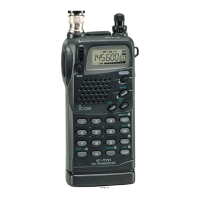4 - 2
The 1st IF signal (45.15 MHz) from the IF amplifier (Q101)
is applied to the 2nd mixer section of IC101 (pin 16), and is
mixed with the 2nd LO signal (45.6 MHZ) for conversion to
a 450 kHz 2nd IF signal at the 2nd mixer section.
The 2nd IF signal (450 kHz) from the 2nd mixer section
(IC101, pin 3) passes through the ceramic filter (FI101)
where unwanted signals are suppressed. It is then amplified
at the limiter amplifier section (IC101, pin 5) and applied to
the quadrature detector section to demodulate the 2nd IF
signal into AF signals.
AF signals output from IC101 (pin 9) are applied to the AF
drive amplifier (Q12) on the LOGIC unit. The S-meter out-
put “SD” signal from IC101 (pin 12) is applied to the CPU
(LOGIC unit; IC1, pin 3).
4-1-7 AF AMPLIFIER CIRCUIT (LOGIC UNIT)
The AF amplifier circuit, including an AF mute switch, ampli-
fies the demodulated signals to drive a speaker.
The demodulated AF signals (“DETO” signals) from the FM
IF IC (IC101) on the 2F unit are applied to the drive amplifi-
er (Q12, pin 3) via the band-pass filter (C44, C45). The
band-pass filter suppresses subaudible tones and higher
noise signal components.
The amplified signals from Q12 (pin 1) pass through the AF
mute switch (Q10) and are then applied to the AF volume
control on the 1F unit via the “AF” signal line.
4-1-8 AF POWER AMPLIFIER CIRCUIT
(2F UNIT)
The AF signals from the AF volume control (“AFV” signals)
are amplified at the AF power amplifier IC (IC151, pin4). The
amplified AF signals are applied to the loud speaker via the
external speaker jack (1F unit; J902).
4-1-9 NOISE SQUELCH UNIT (2F UNIT)
A noise squelch circuit cuts out AF signals when no RF sig-
nal is received. By detecting noise components in the AF
signals, the squelch circuit switches the AF mute switch.
Some of the noise components in the AF signals from the
FM IF IC (IC101, pin 9) are applied to the active filter section
(IC101, pins 7 and 8). The variable register (R504) adjusts
the active filter input level.
The active filter section amplifies noise components with fre-
quencies of 20 kHz and above. The filtered signals are rec-
tified at the noise detector section and converted into
“NOlSE” (pulse type) signals at the noise comparator sec-
tion. The “NOISE” signal is applied to the CPU (LOGIC unit;
IC1, pin 12).
The CPU (LOGIC unit; IC1) detects the signal level from the
number of the pulses, and outputs an “MM/RM” signal from
IC1 pin 44 on LOGIC unit. This signal controls the AF mute
switch (LOGIC unit; Q10) to cut the AF signal line.
4-2 TRANSMITTER CIRCUITS
4-2-1 MICROPHONE AMPLIFIER CIRCUIT
(LOGIC AND 2F UNIT)
The microphone amplifier circuit amplifies audio signals with
+6 dB/octave pre-emphasis from the microphone to a level
needed for the modulation circuit.
The AF signals from the built-in condenser microphone
(LOGIC unit; MC1), or from the [MIC] Jack (1F unit; J901)
via the “EXT MIC” line are applied to the limiter amplifier
(LOGIC unit; IC12, pin 3) which has +6 dB/octave pre-
emphasis characteristics.
The amplified AF signals pass through the splatter filter
(IC12, pins 5–7). The filtered signals are applied to frequen-
cy deviation pots (2F unit; R308 for VHF, R314 for UHF) and
are then applied to the modulation circuit on the DUAL VCO
board.
Q32 on the LOGIC unit is the PTT control circuit and outputs
a “High” signal to the CPU when transmitting.
4-2-2 MODULATION CIRCUIT
(DUAL VCO BOARD)
The modulation circuit modulates the VCO oscillating signal
(RF signal) using the microphone audio signals.
The “VMOD” signals change the reactance of a diode
(D304) to modulate the oscillated signal at the VHF-VCO cir-
cuit (Q304, Q305 and D303).
The “UMOD” signals are applied to the UHF-VCO circuit via
the “USHIFT” line. The applied signals change the reac-
tance of a diode (D302) to modulate the oscillated signal at
the UHF-VCO circuit (Q301, Q302 and D301).
The VCO output is buffer-amplified at Q306 and then
applied to the band switch (D351 and D352) via the LO
amplifiers (Q852 and Q351).
4-2-3 POWER AMPLIFIER CIRCUIT (1F UNIT)
Q401 is a drive and Q402 is a power amplifier. They are
designed to use both VHF and UHF commonly. They pro-
vide more than 6 W for VHF and 6 W for UHF with a 13.5 V
DC power source via one power amplifier system.
An RF signal from the band switch (D351 and D352) is
buffer-amplified at Q201 (for VHF) or Q701 (for UHF) and
then applied to the drive amplifier (PA board; Q401) via the
other band switch (D201 and D701). The applied RF signal
from the band switch is amplified at a drive amplifier (Q401)
and then amplified again at the power amplifier (Q402).
The amplified RF signal is passed through the low-pass fil-
ter (VHF) or high-pass filter (UHF), and then applied to the
antenna connector via the transmit/receive switching circuit
(Q51, D52 and Q202 are for VHF, D551, D552, D722–D724
and Q204 are for UHF).

